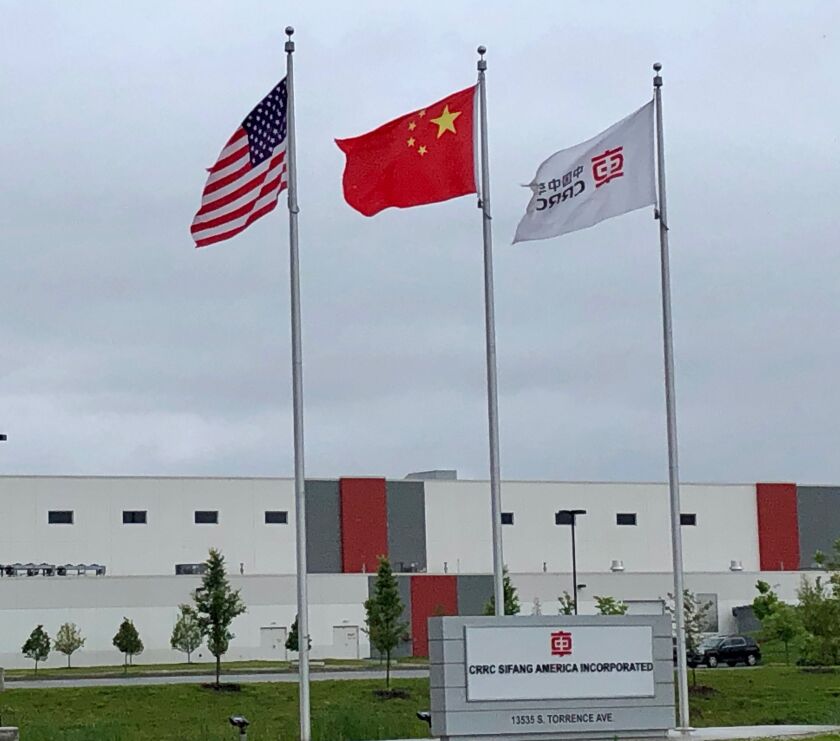Outside, three flags snap in the breeze: the Stars and Stripes of the United States, the five-starred red flag of Communist China, and a white banner representing CRRC Sifang America Inc. or, colloquially, the Chicago Transit Authority’s L car plant in Hegewisch.
Inside, almost lost within a vast, new industrial space, two familiar-looking stainless steel train car bodies are propped six feet in the air, dangling coils of cable, surrounded by a bright yellow platform, the first of the 7000 series: 7001 and 7002.
At the latter, workers in hard hats gather around an electric coupler that doesn’t quite fit, doing what they call a “soft install”: tentatively attaching something and making sure it clears all the obstacles it must avoid on the CTA’s 224 miles of often-cramped track.
CRRC Sifang — the initials stand for China Railways Rolling Stock Corporation — won a $1.3 billion contract in 2016 to produce 846 new rail cars for the CTA; that’s about half the current fleet. That same year, it broke ground on this $100 million, 380,000-square-foot facility to do it.
”Part of the deal was they would build the factory here and build the trains here and all the good stuff that goes along with it, all the jobs,” said David Smolensky, a publicist for the factory.
That’s 100 jobs now — three-fourths of them from IBEW Local 134 and Sheet Metal Workers Local 73 — and 170 by sometime next year. If you’re wondering why a U.S. company didn’t get the work, that’s easy: There are no U.S.-owned companies building passenger railway cars.
CRRC traces its roots back over 100 years, to the Sifang Locomotive Works begun in 1900, and is now the largest builder of high-speed trains in the world. If you don’t feel anxious enough about our country’s slide into infrastructure ruin, consider this: A maglev train built by CRRC hit 267 mph during the 19-mile run from Shanghai’s International Airport.
CRRC also makes rail cars for transit systems in Philadelphia, Boston and Los Angeles. The vast space in Chicago is mostly empty, hinting at ambitious plans.
”Here in Chicago, we’re trying to grow,” said Smolensky. CRRC has already bid on work for Washington, D.C.’s, aging system, and hopes to scoop up Metra, too.
The car shells are made in China, go by boat to Houston or L.A., then are trucked to Chicago.
Moving partially completed rail cars is not an easy task, and the factory has a variety of massive sliding track and lift systems, including a squat but powerful robot called an Omni Turtle, designed to move heavy wheel assemblies.
Testing the cars is crucial. One wing of the plant features adjustable arms holding spiral nozzles so the cars can be blasted with water, and folding metal gateways set to the exact tolerance specifications of the CTA, so nothing protrudes or hangs from the cars that will catch, snag or sheer off while navigating the tight spaces of the Chicago rail system.
”Think about where our elevated structures run,” said the CTA’s Brian Steele. “The CTA has one of the smaller and narrower rail cars among older U.S. transit systems. Look at the curves on the Loop; those are pretty tight curves.”
By law, 69% of each rail car must be U.S.-sourced; boxes from Kustom Seating Unlimited of Bellwood wait patiently.
”CRRC has been a good partner to work with,” said Keith Nippes, president of Kustom. The big innovation in this new series, he said, is that rather than being supported by pillars, these seats are cantilevered out of the wall, making cars easier to clean.
The 7000 series car has 37 or 40 seats, depending whether it is an A or B configuration, and cars always are coupled — one A, one B. That’s why L trains have an even number of cars. L cars mate for life, like swans. Thus 7001 and 7002, born across from each other in Hegewisch and delivered to the CTA later this year, will spend the next 30 years or so navigating the tight curves of Chicago hand-in-hand.
”We’re very excited about these new rail cars,” said Steele. “When they’re delivered, the CTA will have one of the youngest rail fleets of any in the country,”
Young, exploring exciting curves and bonded for life. Who could imagine that a story about construction of L cars would end up a romance?






